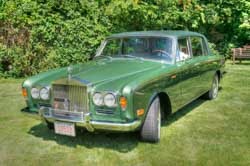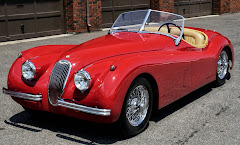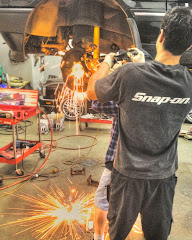Are you thinking about a closed trailer to move your collector
car to events?
The first question to ask is: Do you have a vehicle that can haul your pet
car in a trailer? If you want to move a
full sized car it’s going to weigh 4-5,000 pounds, plus a similar weight of
trailer and gear. In total you will have
a towed load near 10,000 pounds. Even little cars weigh more than you
think. A vintage MINI or a small racecar
is a 6-7,000 pound load in many cases.
That kind of rig is best pulled by a full-sized 2500 or 3500
pickup with the biggest possible engine (this means your rig will probably get
all of 10mpg if lucky). If you don’t
have a suitable tow vehicle you may consider renting. Outfits like Penske rent late model 2500
trucks with tow packages. Professional
haulers will use even bigger rigs, with gooseneck or fifth wheel couplers.
We use a 24 foot trailer, which gives about 6 feet of
storage and work room in front of a large car.
Others prefer 28 foot trailers for even more clearance. If you’re moving full size cars like
Rolls-Royce or vintage American iron things will get really tight in anything
smaller.
If you buy a new trailer it’s probably going to come with a
basic ball hitch. Most professionals I
know use a load distributing system to shift some of the tongue weight to the
front wheels of the tow vehicle. Sway
dampers are another common addition. The
trailer needs a jack at the front to uncouple it safely, and it’s smart to have
jacks in the rear so you can load and unload without being hooked to the tow
vehicle.
The most important thing to remember when you load the car
is to drive it far enough forward that you have a decent weight on the hitch,
but not so far forward that too much weight is on the coupling. A good rule of thumb is that the tongue
weight should be about 10% of the trailer weight.
With a 10,000lb load that means a tongue weight of 1,000
pounds or so. It’s important to make
sure the hitch and coupling are both rated for that weight. If you have a late-model 2500 or larger truck
with factory tow package it’s likely to use the commercial 2.5 inch square
system, which will handle that no problem.
Older vehicles may be challenged.
You can check your tongue weight with a tongue weight scale
(available from an RV dealer) or by weighing the rig on a commercial scale. If
your tongue weight is too high you can reduce it by moving the car back in the
trailer, but don’t move it back too far.
Low tongue weight is the main cause of instability and sway in trailers.
If you’re using a weight distributing
hitch you should look at its instructions to level the truck now. Don’t forget to grease the hitch balls and
pivots too.
Once you’ve figured out where to position the car in the
trailer for proper balance the next step is to tie it down. If you’re doing this for the first time, you
might want to mark the positions of the wheels and unload the car, because you
will need to add tie down points.
There are two good choices to tie the car to the
trailer. Either tie the wheels to the
trailer floor, or tie the suspension to the floor. In both cases, the tie downs leave the
vehicle free to move up and down over bumps.
If you tie the vehicle down by the body with short up and
down straps (the way cars were secured on multi car carriers for decades) they
will be slamming the straps every time the bounces up and down, and eventually
something will break. The only way to
avoid movement over bumps will be to cinch the car down so tight the suspension
is fully compressed. Few people move
cars in single car trailers that way today because the risk of damage is too
high.
We use two methods to secure cars. The first is called e-track, and it’s similar to the l-track used
in airplanes. We have tracks running
front to back along the floor of the trailer, and the car is driven in atop
them. We put heavy rubber chocks in
front of the wheels and then snap e track straps into the floor behind the
wheels. The straps pass over the wheels
to a loop in front of the tire. The
strap stretched forward to a tensioner latched into the track just in front of
the car.
In the rear we put loops of strap around the rear axle
braces, and hook straps from there to rings that are set into the trailer
floor. Those are our principal means of
keeping the car in place on heavy deceleration.
To do that job, it is important that the rings and e tract
be secured with nuts and bolts through the trailer floor and frame. If you buy a trailer “set up” I suggest you
check this carefully because many people install tie down points with sheet
metal screws or even wood screws and those weak attachments will rip out under
stress!
Once the car is safely tied down it’s time to think about
what else you’ll need to bring. One
obvious thing is a spare tire. Our
trailer has four tires. If you run over
something that damages one tire, it’s likely to damage both. For that reason we carry two spare tires,
tied down to more e-track in the front of the trailer.
What about changing the tire? To do that you will need to get a jack under
the trailer axle, and the jack must be strong enough to lift a loaded
trailer. I carry a 3.5 ton floor jack
from our shop for this purpose. You
might look at that jack in the trailer and think it’s overkill but I assure you
the tune would change as soon as you faced a flat tire on a dirt roadside with
something less. We keep a tool box in
the trailer with a battery powered impact gun and hand wrenches for the wheel
lugs and all the hardware on the trailer and hitch. We also carry a few spare lug nuts.
PRO TIP: Make sure your jack will fit under the trailer if both tires on one side are flat, and make sure you have enough spares to change out a side (usually two to three tires)
PRO TIP: Make sure your jack will fit under the trailer if both tires on one side are flat, and make sure you have enough spares to change out a side (usually two to three tires)
I really encourage you to test your tools for this at home,
to be sure you can actually change a tire at night by the side of the
road. That is no time to discover your
lug wrench isn’t strong enough or the jack won’t lift the trailer.
Before driving off you should check the tightness of all the
hardware on the hitch and tow rig. Check
the wheel lugs and check the pressure in the truck and trailer tires. In most cases the trailer tires will be
inflated to the pressure stamped in the tire sidewall. Follow the recommendations in the owner’s
manual for the tires on the truck.
Check the trailer brakes and the brake controller. Any closed trailer should have electric
brakes. One tip – if the trailer starts
to sway when you’re on the highway you can often damp it by touching the
trailer brake while the tow vehicle coasts.
Applying the tow vehicle brake in that situation may make your sway
worse.
What if a tire goes low?
A low tire may mean a leak, and for that you can purchase liquid stop
leak. It’s an aerosol that partly
inflates and plugs a leaking tire at the same time. It’s often an effective temporary repair for
nail punctures and similar damage. Some
people carry battery powered compressors to pump up tires, but I find them
unacceptably slow. We also carry a 12 gallon tank of 125psi compressed air that
can quickly inflate tires on the tow rig or on the vehicles we are towing.
TIP: Carry an infrared thermometer in your truck and shoot the temps on the tires at every stop. Trailer tires should be even 100-140 degrees in temperate weather. A higher temp usually means low air or damage. The truck rear tires may run a bit hotter unless you have duel wheels, which will probably be cooler
TIP: Carry an infrared thermometer in your truck and shoot the temps on the tires at every stop. Trailer tires should be even 100-140 degrees in temperate weather. A higher temp usually means low air or damage. The truck rear tires may run a bit hotter unless you have duel wheels, which will probably be cooler
You would be wise to pack a set of flares in your tool box,
along with 4 chocks for the trailer and truck wheels. The list of other tools you may carry depends
on your abilities. In addition to hand
tools we pack several battery powered lights and lanterns that are essential
for any repairs at night. We carry
Milwaukee M18 battery powered lights and impact wrenches. They make a really nice blower whose power
rivals that of a small gas leaf blower.
We use it to dry cars after washing, and to blow dust off the paint or
out of the interior. You can find
similar tools from Makita and other makers – battery power has really taken
over!
We pack a big co2 fire extinguisher, as well as a dry
chemical unit in the cab of the truck.
If you have to put out a fire in a collector car co2 or Halon gas is
what you want because it’s won’t leave nasty residue but you need a big
extinguisher to do the job. They are
expensive but worth in, for damage avoided.
When you get to the show you may end up parking the trailer
and driving off in the truck. If you do
it will be smart to lock the trailer against theft. We use high security padlocks on the rear
door, a quality dead bolt latch for the side door, and a lock on the
coupler. When the trailer is hooked to
the truck we lock the hitch to the vehicle and we lock the release pin on the
trailer.
With all that preparation we hope to get our cars to the
show fields in the same pristine condition they were in when we loaded. If it doesn’t, our trailer carries polish,
towels and other cleaning supplies for on-field touch up. The battery powered air gun is a great help. We usually carry some lightweight drive-on
ramps too in case anything needs attention on the ground. And speaking of the ground – don’t forget a
foam pad (like a yoga mat) or at least a big beach towel to lay on when you
hook up under the car, etc.
Before you set out, I suggest gathering the registration and
insurance documents for the truck, trailer, and show car in one place, in case
you get pulled over. Better to discover
any problems now so you don’t end up in a country pokey later. Make sure registrations and inspections are
all up to date and your loaded rig is not over its registered weight
limit. Check carefully for any potential
violations on either the truck or the trailer.
With all that, I hope your towing and showing experience is
a good one. See you on the road!
(c) 2016 John Elder Robison
John Elder Robison is the general manager of J E Robison Service Company, celebrating 30 years of independent Land Rover, Rolls-Royce and Bentley restoration and repair in Springfield, Massachusetts. John is a longtime technical consultant to the Land Rover, Rolls-Royce and Bentley clubs, and he’s owned and restored many fine British motorcars. Find him online at www.robisonservice.com or in the real world at 413-785-1665
Reading this article will make you smarter, especially when it comes to car stuff. So it's good for you. But don't take that too far - printing and eating it will probably make you sick.


































No comments:
Post a Comment